The Travelers Monument along the Mojave Road is a compelling landmark steeped in history and camaraderie, offering a unique experience for those exploring the Mojave Desert. Let SIXT.VN guide you through discovering Vietnam’s hidden gems, much like the Mojave Road’s secrets. Consider SIXT.VN your reliable partner for seamless travel planning, airport transfers, hotel bookings, and curated tour packages, ensuring an unforgettable Vietnamese adventure. Discover cultural experiences, scenic beauty, and vibrant city life.
1. What is the Significance of the Travelers Monument?
The Travelers Monument, nestled along the historic Mojave Road, stands as a testament to the enduring spirit of travelers and adventurers who have traversed this rugged terrain for centuries. This unique landmark, marked by a substantial pile of rocks, holds within it a buried monument with a plaque containing a secret message. Each traveler is encouraged to contribute a rock to the ever-growing pile, symbolizing a shared journey and a collective memory of those who have passed through this iconic route.
1.1 Historical Roots and Evolution
The Mojave Road, originally a network of trails used by Native Americans for trade and sustenance, was later adopted by Spanish missionaries, explorers, and settlers. Over time, it evolved into a vital passage connecting the desert dwellers with coastal communities. Today, it remains a challenging yet rewarding path for off-road enthusiasts, history buffs, and nature lovers. According to research from the Bureau of Land Management in 2018, the Mojave Road sees over 10,000 visitors annually, highlighting its continued significance as a recreational and historical resource.
1.2 The Ritual of Adding a Rock
One of the most engaging aspects of visiting the Travelers Monument is the ritual of adding a rock to the pile. This tradition, passed down through generations of travelers, serves as a symbolic gesture of participation in the ongoing story of the Mojave Road. Each rock represents an individual’s journey, their challenges, and their triumphs, all contributing to the collective narrative of the monument.
1.3 The Buried Plaque and its Secret Message
Beneath the ever-growing pile of rocks lies a monument with a plaque, its message shrouded in secrecy. Visitors who manage to scramble to the top of the pile are rewarded with the opportunity to read the inscription, but are then sworn to keep its contents confidential. This element of mystery adds to the allure of the Travelers Monument, encouraging travelers to make the journey and discover its secrets for themselves.
1.4 The Monument as a Symbol of Shared Experience
The Travelers Monument embodies the spirit of shared experience and camaraderie among those who have traveled the Mojave Road. It serves as a tangible reminder that, despite individual journeys and personal challenges, all travelers are connected through their common experience of traversing this historic route.
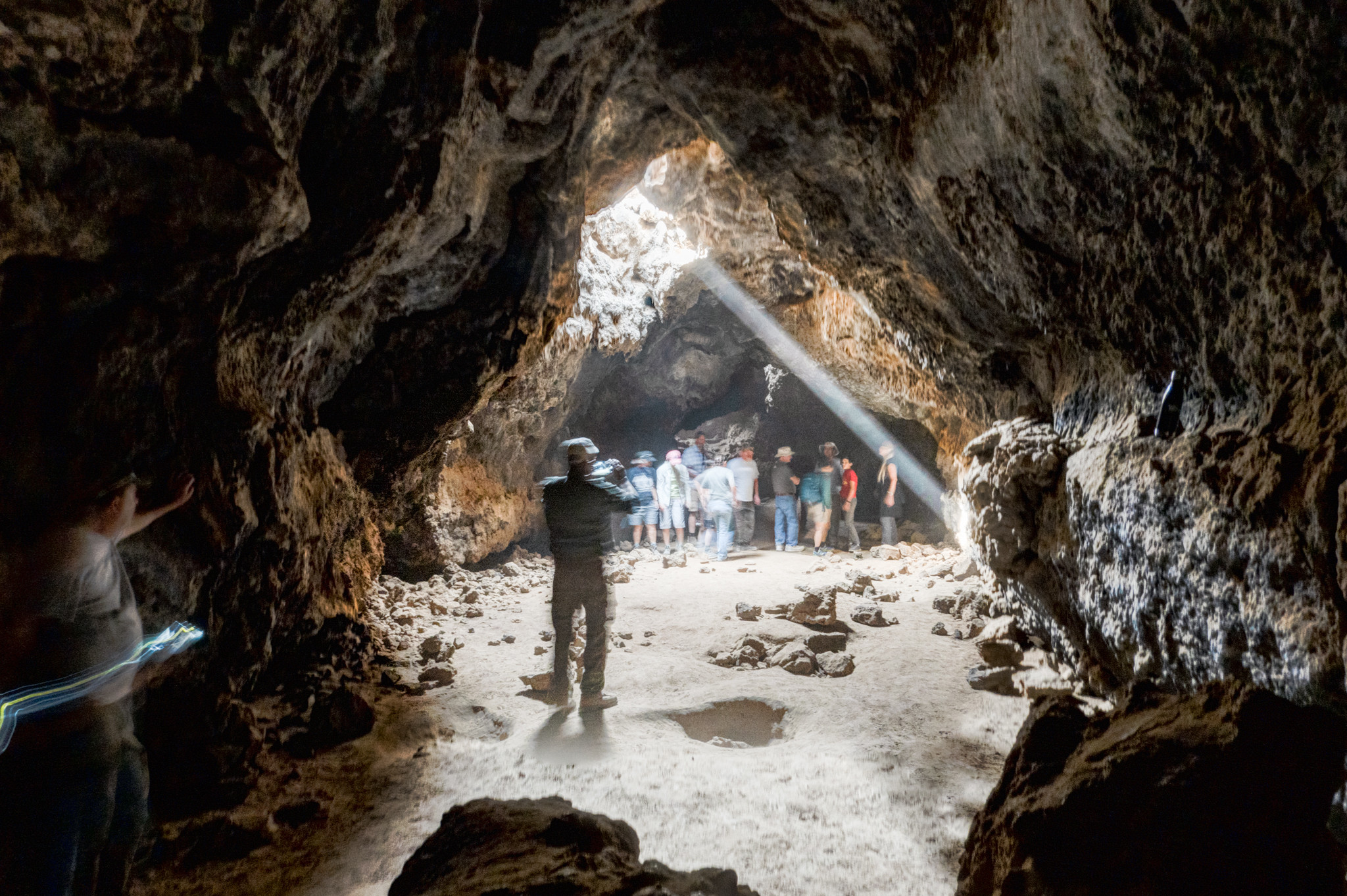 Travelers adding rocks to the monument, symbolizing shared journeys
Travelers adding rocks to the monument, symbolizing shared journeys
2. Planning Your Visit to the Travelers Monument: A Detailed Guide
Embarking on a journey to the Travelers Monument requires careful planning to ensure a safe and enjoyable experience. Here’s a comprehensive guide to help you prepare for your visit.
2.1 Best Time to Visit
The optimal time to visit the Mojave Desert is during the cooler months, from October to April. During this period, temperatures are more moderate, making outdoor activities more comfortable. Summer months can be extremely hot, with temperatures often exceeding 100°F (38°C), which can pose a significant risk, especially for those unfamiliar with desert conditions.
2.2 Necessary Preparations
2.2.1 Vehicle Requirements
The Mojave Road is a challenging off-road route that requires a reliable four-wheel-drive vehicle with high clearance. Ensure your vehicle is in good working condition and equipped with appropriate tires for off-road terrain.
2.2.2 Essential Supplies
- Water: Carry an ample supply of water, at least one gallon per person per day. Dehydration can occur quickly in the desert environment.
- Food: Pack non-perishable food items that are easy to prepare and consume.
- Navigation Tools: A GPS device, maps, and a compass are essential for navigating the Mojave Road.
- Communication Devices: A satellite phone or two-way radio is recommended, as cell phone service is unreliable in many areas.
- First Aid Kit: Include a comprehensive first aid kit with supplies to treat minor injuries, burns, and dehydration.
- Sun Protection: Wear sunscreen, a hat, and sunglasses to protect yourself from the intense desert sun.
- Tools and Spare Parts: Carry essential tools and spare parts for your vehicle, such as a tire repair kit, extra fluids, and a jack.
2.2.3 Safety Precautions
- Inform Someone of Your Plans: Always let someone know your itinerary and expected return time.
- Travel in Groups: Traveling with other vehicles is recommended for added safety and assistance in case of emergencies.
- Stay on Marked Trails: Avoid straying from marked trails to minimize the risk of getting lost or damaging the environment.
- Be Aware of Wildlife: The Mojave Desert is home to various wildlife, including snakes, scorpions, and spiders. Be cautious and avoid approaching or disturbing animals.
2.3 Detailed Route Information
The Mojave Road spans approximately 138 miles, traversing a diverse range of terrains from sandy flats to rocky mountains. The route is generally well-marked, but it is essential to have detailed maps and GPS coordinates to stay on course.
2.3.1 Key Landmarks Along the Route
- Fort Piute: A historic fort that once served as a military outpost.
- School Bus Camp: A former campsite marked by an abandoned school bus.
- Mojave Mailbox: A quirky mailbox where travelers can leave messages and sign their names.
- Lava Tube: A fascinating geological formation that offers a unique underground experience.
- Travelers Monument: The iconic pile of rocks that marks the end of the journey.
2.3.2 Navigational Tips
- Use a GPS Device: A GPS device with pre-loaded maps of the Mojave Road can be invaluable for navigation.
- Carry Paper Maps: Always carry paper maps as a backup in case of GPS failure.
- Pay Attention to Trail Markers: The Mojave Road is marked with wooden posts and cairns. Pay close attention to these markers to stay on the correct route.
2.4 Accommodation Options
2.4.1 Camping
Camping is a popular option for travelers on the Mojave Road. There are several established campgrounds along the route, including:
- Afton Canyon Campground: Offers campsites with picnic tables, fire rings, and restrooms.
- Hole-in-the-Wall Campground: Located in the Mojave National Preserve, this campground offers stunning views and access to hiking trails.
2.4.2 Hotels
If you prefer more comfortable accommodations, there are several hotels located in nearby towns such as:
- Barstow: Offers a range of hotels, motels, and restaurants.
- Needles: Located on the Colorado River, Needles provides a variety of lodging options.
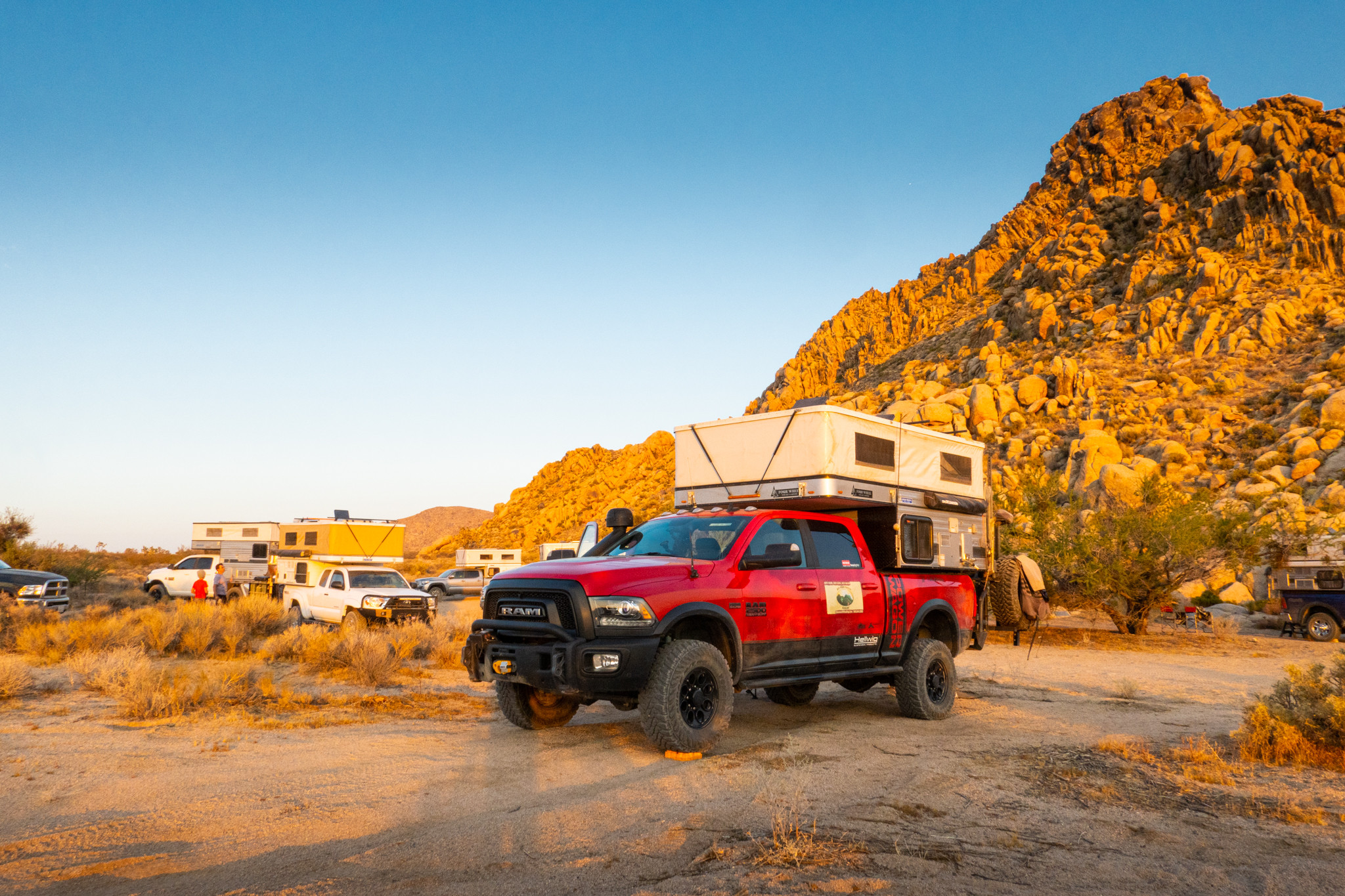 Off-road vehicle navigating rocky terrain on the Mojave Road
Off-road vehicle navigating rocky terrain on the Mojave Road
3. Experiencing the Mojave Road: Key Attractions and Activities
The Mojave Road offers a wealth of attractions and activities for travelers seeking adventure, history, and natural beauty. Here are some of the highlights you can expect to encounter along the way.
3.1 Fort Piute: A Glimpse into the Past
Fort Piute stands as a historic reminder of the military presence in the Mojave Desert during the 19th century. Established in 1867, the fort served as a strategic outpost to protect settlers and maintain peace between Native American tribes and the expanding United States. Today, visitors can explore the remnants of the fort, including stone foundations and interpretive signs that recount its history.
3.1.1 History of Fort Piute
Fort Piute was established in response to increasing tensions between settlers and the local Paiute Native American tribe. The fort provided a safe haven for travelers and served as a base for military operations in the region. Although it was only occupied for a short period, Fort Piute played a significant role in shaping the history of the Mojave Desert.
3.1.2 Exploring the Ruins
Visitors to Fort Piute can wander through the ruins of the fort, imagining what life was like for the soldiers who once called this place home. The stone foundations of the buildings are still visible, and interpretive signs provide information about the fort’s history and significance.
3.2 The Mojave Mailbox: A Quirky Landmark
The Mojave Mailbox is a whimsical landmark that embodies the spirit of the Mojave Road. Located along the route, this mailbox serves as a place where travelers can leave messages, sign their names, and share their experiences. Over the years, the mailbox has become a repository of stories, memories, and well-wishes from travelers around the world.
3.2.1 The Tradition of Leaving Messages
One of the most enjoyable aspects of visiting the Mojave Mailbox is the tradition of leaving a message for future travelers. Whether it’s a simple greeting, a word of encouragement, or a detailed account of your journey, your message will become part of the ongoing story of the Mojave Road.
3.2.2 Reading Past Travelers’ Stories
Take some time to browse through the messages left by previous travelers. You’ll find tales of adventure, perseverance, and camaraderie that will inspire you on your own journey.
3.3 The Lava Tube: A Subterranean Adventure
The Lava Tube is a fascinating geological formation that offers a unique subterranean experience. Formed by ancient volcanic activity, this tube is a cave-like structure that provides a cool and dark escape from the harsh desert environment.
3.3.1 Exploring the Tube
Visitors can explore the Lava Tube by descending into its depths and navigating its winding passages. Be sure to bring a flashlight or headlamp to illuminate your way and admire the unique rock formations.
3.3.2 Safety Precautions
Exercise caution when exploring the Lava Tube. The ground can be uneven and slippery, so wear sturdy shoes and watch your step.
3.4 Wildlife Encounters
The Mojave Desert is home to a diverse array of wildlife, including:
- Desert Tortoises: These gentle reptiles are a protected species. If you encounter one, observe it from a distance and do not disturb it.
- Bighorn Sheep: These majestic animals can be seen grazing on the rocky slopes of the mountains.
- Coyotes: These adaptable predators are common in the Mojave Desert. Keep a safe distance and do not feed them.
- Roadrunners: These fast-running birds are a delight to watch as they dart across the desert landscape.
3.4.1 Respecting Wildlife
When encountering wildlife, it is essential to respect their space and avoid disturbing their natural behavior. Observe animals from a distance, do not feed them, and never approach or attempt to handle them.
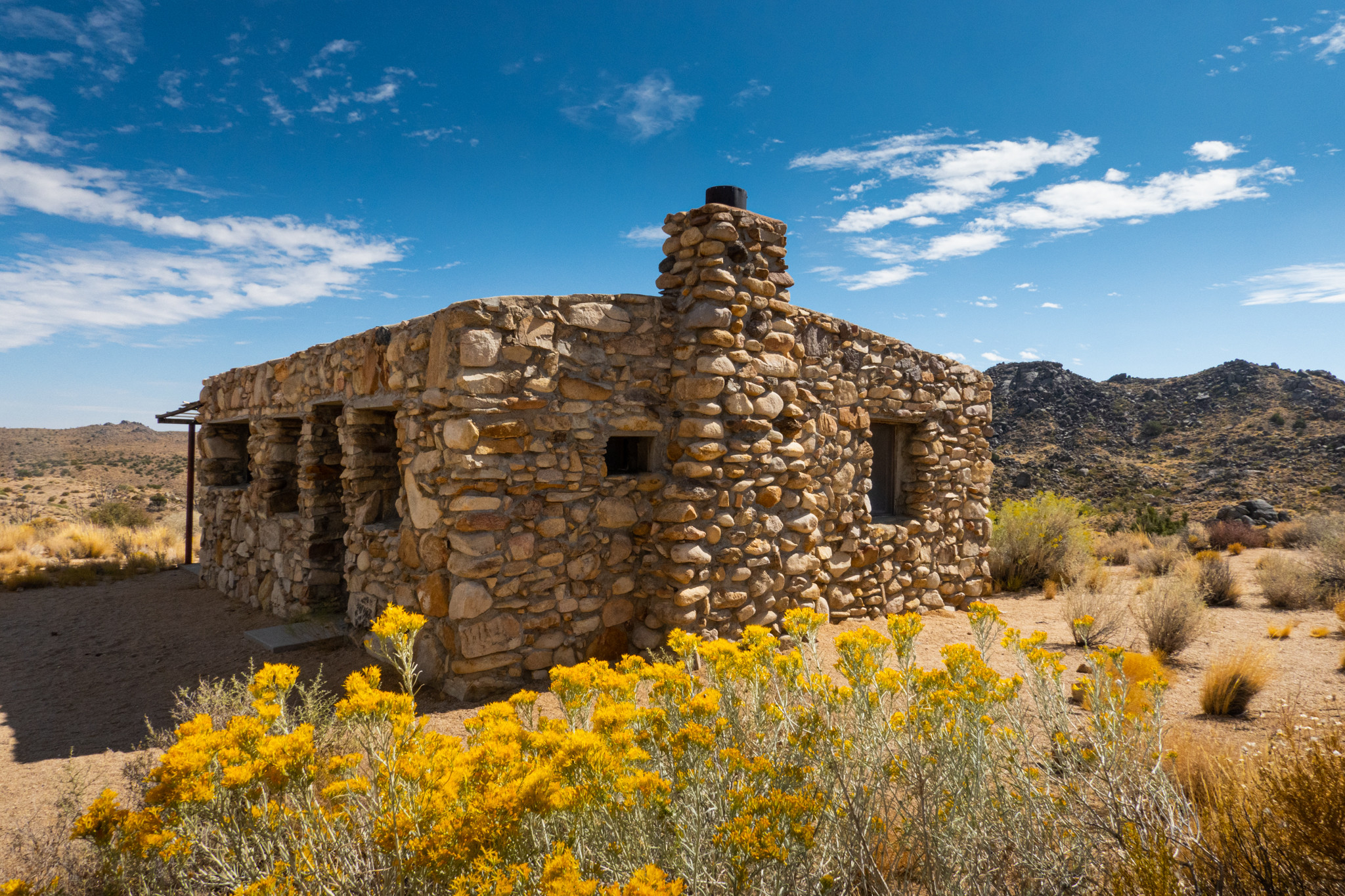 Desert landscape with Joshua Trees along the Mojave Road
Desert landscape with Joshua Trees along the Mojave Road
4. Essential Gear and Equipment for the Mojave Road
Venturing onto the Mojave Road demands meticulous preparation, particularly concerning the gear and equipment you carry. The key is to ensure you’re self-sufficient, prepared for any eventuality, and capable of handling the rigorous conditions of the desert.
4.1 Must-Have Vehicle Equipment
4.1.1 Four-Wheel Drive Vehicle
A sturdy four-wheel-drive vehicle with high clearance is not just recommended; it’s essential. The terrain varies drastically, from soft sand to sharp, rocky paths.
4.1.2 Suitable Tires
Equip your vehicle with tires designed for off-road use. All-terrain or mud-terrain tires provide the necessary grip and durability to tackle the Mojave Road’s challenges.
4.1.3 Tire Pressure Monitoring System (TPMS)
A TPMS allows you to monitor tire pressure in real-time, crucial for adjusting to varying terrains. Lowering tire pressure can improve traction on sandy surfaces, while higher pressure is better for paved roads.
4.1.4 Recovery Gear
- Tow Straps: Essential for pulling vehicles out of sand or mud.
- Shovel: For digging out bogged-down vehicles.
- Traction Boards: These provide temporary traction on slippery surfaces.
- Jack and Jack Plate: For safely lifting your vehicle to change a tire.
4.1.5 Communication Devices
- Satellite Phone: Cell service is unreliable, making a satellite phone a vital communication tool in emergencies.
- Two-Way Radios: Useful for communicating with other vehicles in your group.
4.2 Personal Gear
4.2.1 Navigation Tools
- GPS Device: A GPS device with pre-loaded maps of the Mojave Road is essential for staying on course.
- Compass and Maps: Always carry physical maps as a backup in case of GPS failure.
4.2.2 Clothing
- Moisture-Wicking Fabrics: These fabrics help keep you cool and dry in the desert heat.
- Layers: Temperatures can fluctuate dramatically, so bring layers of clothing to adapt to changing conditions.
- Wide-Brimmed Hat: Provides protection from the sun.
- Sunglasses: Protect your eyes from the sun’s glare.
4.2.3 Hydration
- Water Storage: Carry enough water for drinking, cooking, and cleaning. A good rule of thumb is one gallon per person per day.
- Water Filter or Purification Tablets: Essential for treating water from natural sources.
4.2.4 First Aid Kit
A comprehensive first aid kit should include:
- Bandages and gauze
- Antiseptic wipes
- Pain relievers
- Antihistamines
- Burn cream
- Tweezers
- Scissors
4.2.5 Lighting
- Headlamp: Essential for navigating around the campsite at night.
- Flashlight: A backup light source.
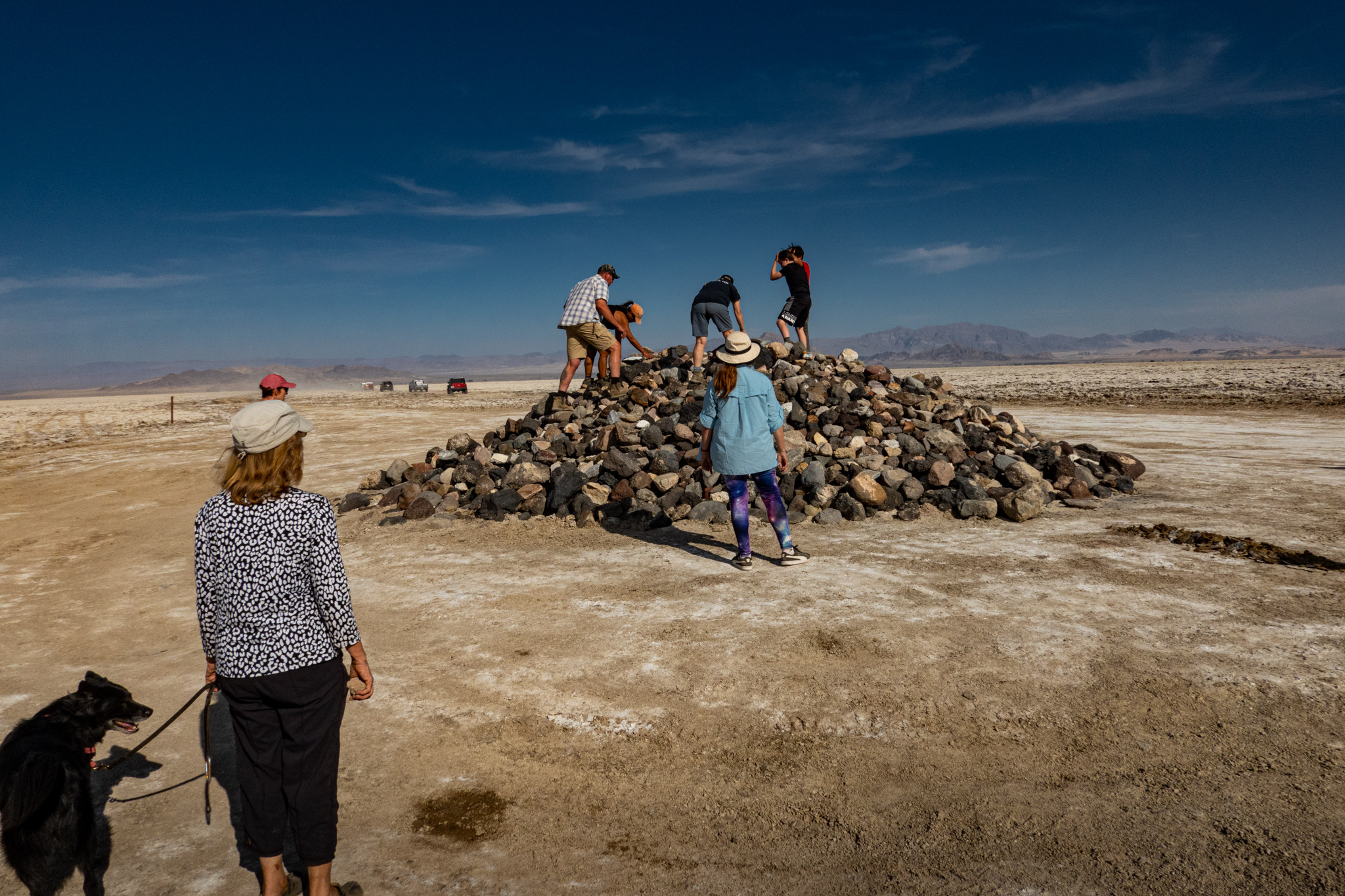 Group of travelers gathered at the Travelers Monument, adding rocks to the pile
Group of travelers gathered at the Travelers Monument, adding rocks to the pile
5. Sustainable Travel Practices on the Mojave Road
Engaging in sustainable travel practices is crucial for preserving the natural beauty and ecological integrity of the Mojave Road for future generations. By minimizing your environmental impact and respecting local communities, you can ensure that this iconic route remains a cherished destination for years to come.
5.1 Leave No Trace Principles
The Leave No Trace principles provide a framework for minimizing your impact on the environment. These principles include:
- Plan Ahead and Prepare: Research the area you will be visiting, pack appropriately, and be prepared for changing weather conditions.
- Travel and Camp on Durable Surfaces: Stick to established trails and campsites to avoid damaging vegetation and soil.
- Dispose of Waste Properly: Pack out everything you pack in, including trash, food scraps, and human waste.
- Leave What You Find: Avoid taking souvenirs or disturbing natural objects.
- Minimize Campfire Impacts: Use a portable stove for cooking and avoid building campfires whenever possible.
- Respect Wildlife: Observe wildlife from a distance and avoid feeding them.
- Be Considerate of Other Visitors: Respect the privacy of other visitors and minimize noise.
5.2 Minimizing Environmental Impact
5.2.1 Stay on Designated Roads and Trails
Driving or hiking off-road can damage fragile desert ecosystems. Stay on designated roads and trails to avoid disturbing vegetation, soil, and wildlife habitats.
5.2.2 Avoid Disturbing Wildlife
The Mojave Desert is home to a variety of wildlife species, including desert tortoises, bighorn sheep, and various birds and reptiles. Observe wildlife from a distance and avoid approaching or feeding them.
5.2.3 Conserve Water
Water is a precious resource in the desert. Conserve water by using it sparingly and avoiding unnecessary waste.
5.2.4 Proper Waste Disposal
Dispose of waste properly by packing out everything you pack in. Use designated trash receptacles whenever possible, and avoid littering.
5.3 Respecting Local Communities
5.3.1 Be Mindful of Private Property
Respect private property by staying on public lands and avoiding trespassing.
5.3.2 Support Local Businesses
Support local businesses by purchasing goods and services from local vendors.
5.3.3 Learn About Local Culture
Take the time to learn about the history and culture of the local communities.
6. Travelers Monument: A Personal Reflection
The Travelers Monument is more than just a pile of rocks; it’s a symbol of shared experiences, perseverance, and the human connection to the land. Standing at the monument, you can’t help but feel a sense of awe and respect for the travelers who have come before you, each leaving their mark on this iconic landmark.
6.1 The Significance of Leaving a Rock
The act of adding a rock to the pile is a deeply personal experience. It’s a way of connecting with the past and future travelers, and of contributing to the ongoing story of the Mojave Road.
6.2 The Experience of Reaching the Top
Scrambling to the top of the pile to read the plaque is a challenging but rewarding experience. The panoramic views of the surrounding desert landscape are breathtaking, and the secret message on the plaque is a reminder of the enduring spirit of adventure.
6.3 The Sense of Accomplishment
Completing the Mojave Road is a significant accomplishment. It’s a test of endurance, skill, and determination. Reaching the Travelers Monument is a moment of triumph, a celebration of your journey and the challenges you have overcome.
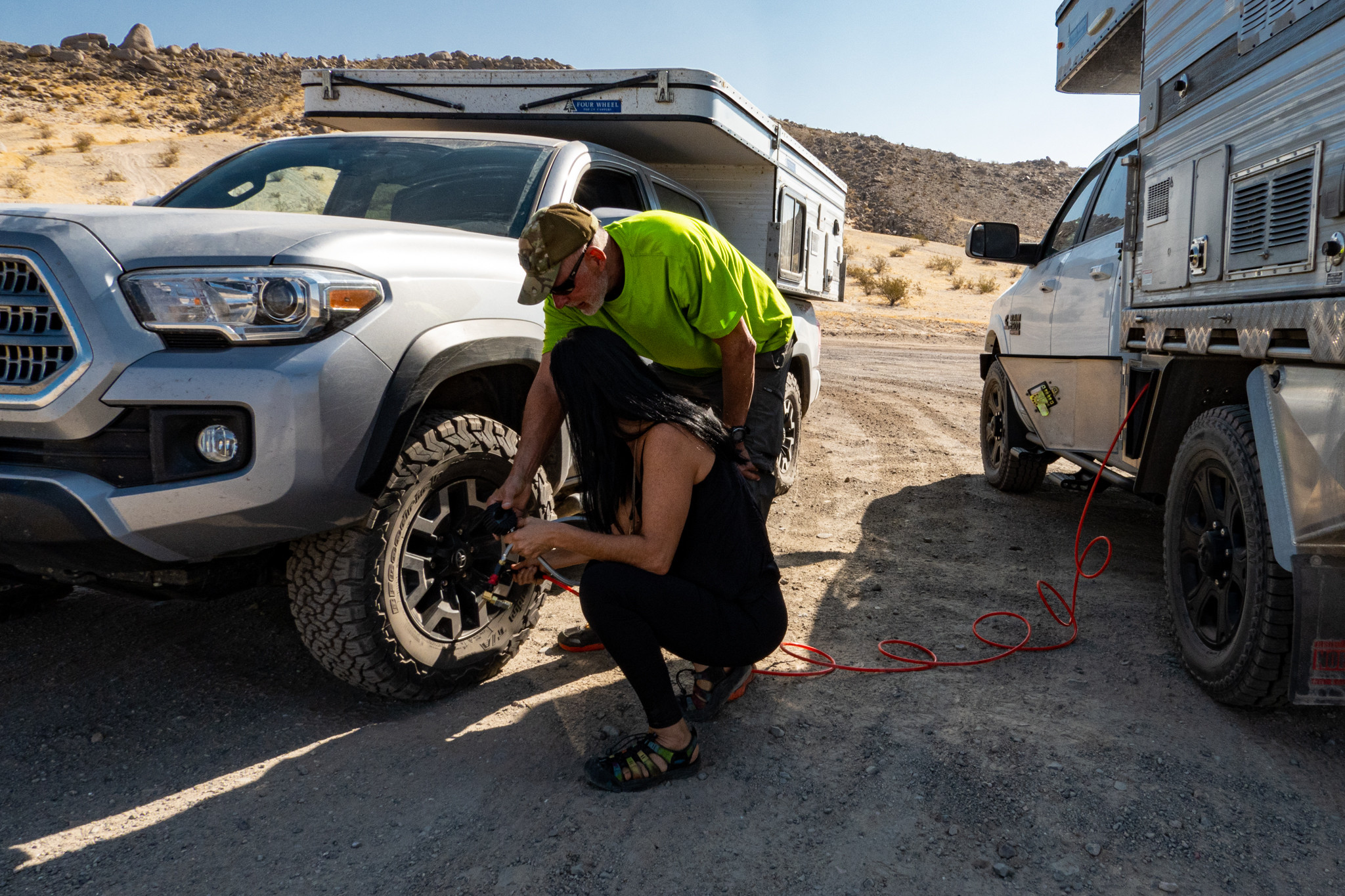 Travelers at the summit of the rock pile, looking at the plaque at the Travelers Monument
Travelers at the summit of the rock pile, looking at the plaque at the Travelers Monument
7. How SIXT.VN Enhances Your Travel Experience in Vietnam
Planning a trip to Vietnam involves several key aspects such as transportation, accommodation, and activities. SIXT.VN offers comprehensive services to streamline these processes, ensuring a hassle-free and enjoyable travel experience.
7.1 Seamless Airport Transfers
SIXT.VN provides reliable and convenient airport transfer services. Whether you’re arriving at Noi Bai International Airport (HAN) in Hanoi or any other airport in Vietnam, SIXT.VN ensures a smooth transition from the airport to your hotel.
7.1.1 Benefits of SIXT.VN Airport Transfers
- Convenience: Pre-booked transfers eliminate the need to negotiate with local taxi drivers or navigate public transport.
- Reliability: SIXT.VN’s professional drivers are punctual and ensure you reach your destination on time.
- Safety: All drivers are vetted and vehicles are well-maintained, providing a safe and comfortable ride.
7.2 Wide Range of Accommodation Options
SIXT.VN offers a diverse selection of accommodations to suit different preferences and budgets. From luxury hotels in bustling cities to cozy guesthouses in serene countryside locations, you can find the perfect place to stay.
7.2.1 Types of Accommodations Available
- Luxury Hotels: Enjoy world-class amenities, fine dining, and impeccable service.
- Boutique Hotels: Experience unique charm and personalized attention in stylishly designed properties.
- Budget-Friendly Hostels: Ideal for solo travelers and backpackers looking for affordable and sociable accommodations.
- Homestays: Immerse yourself in local culture by staying with Vietnamese families and experiencing their hospitality.
7.3 Curated Tour Packages
SIXT.VN offers expertly designed tour packages that showcase the best of Vietnam. These packages cater to various interests, including cultural exploration, natural beauty, and culinary adventures.
7.3.1 Popular Tour Packages
- Hanoi City Tour: Discover the historic landmarks, vibrant markets, and delicious street food of Vietnam’s capital.
- Ha Long Bay Cruise: Explore the stunning limestone karsts and emerald waters of this UNESCO World Heritage site.
- Sapa Trekking Adventure: Hike through picturesque rice terraces and visit ethnic minority villages in the northern highlands.
- Mekong Delta Exploration: Cruise along the Mekong River, visit floating markets, and experience the rural lifestyle of southern Vietnam.
7.4 Easy Booking Process
SIXT.VN simplifies the booking process, allowing you to reserve your transportation, accommodation, and tours with ease. The user-friendly website and mobile app provide a seamless experience from start to finish.
7.4.1 Steps to Book with SIXT.VN
- Visit the SIXT.VN website or download the mobile app.
- Select your desired service, such as airport transfer, hotel booking, or tour package.
- Enter your travel dates, destinations, and other relevant information.
- Browse the available options and choose the one that best suits your needs.
- Review your booking details and proceed to payment.
- Receive confirmation of your booking and get ready for your trip.
By leveraging SIXT.VN’s comprehensive services, you can focus on enjoying your trip to Vietnam without the stress of logistical planning. Whether you’re a solo traveler, a couple, a family, or a group of friends, SIXT.VN ensures a memorable and seamless travel experience.
8. Tips for a Safe and Enjoyable Trip to Vietnam
Traveling to Vietnam can be an exciting adventure, but it’s important to be prepared and take necessary precautions to ensure a safe and enjoyable experience.
8.1 Health and Safety
8.1.1 Vaccinations and Health Precautions
Before traveling to Vietnam, consult your doctor about recommended vaccinations and health precautions. Common vaccinations include Hepatitis A, Typhoid, and Tetanus. It’s also advisable to take precautions against mosquito-borne diseases like Dengue Fever and Zika Virus by using insect repellent and wearing protective clothing.
8.1.2 Food and Water Safety
Be cautious about food and water safety to avoid getting sick. Drink bottled water and avoid ice in drinks. Eat at reputable restaurants and street food stalls, and make sure food is cooked thoroughly.
8.1.3 Travel Insurance
Purchase comprehensive travel insurance that covers medical expenses, trip cancellations, and loss of belongings.
8.2 Local Customs and Etiquette
8.2.1 Dress Code
Dress modestly when visiting religious sites such as temples and pagodas. Avoid wearing revealing clothing and remove your shoes before entering.
8.2.2 Greetings
Vietnamese people often greet each other with a slight bow. When meeting someone for the first time, it’s polite to use formal greetings and titles.
8.2.3 Bargaining
Bargaining is common in markets and street stalls. Start by offering a lower price than the asking price and be prepared to negotiate.
8.3 Transportation Tips
8.3.1 Motorbike Taxis
Motorbike taxis (xe ôm) are a popular mode of transportation in Vietnam. Agree on a price before getting on and wear a helmet.
8.3.2 Taxis
Use reputable taxi companies like Mai Linh or Vinasun. Make sure the meter is running or agree on a price before starting your journey.
8.3.3 Public Transportation
Buses and trains are affordable options for traveling between cities. Book tickets in advance, especially during peak season.
8.4 Common Scams to Avoid
8.4.1 Overcharging
Be aware of overcharging, especially in tourist areas. Always check prices and negotiate if necessary.
8.4.2 Fake Taxis
Avoid using unofficial taxis that may overcharge or take you to the wrong destination. Stick to reputable taxi companies.
8.4.3 Shoe Shiners
Be wary of shoe shiners who may offer unsolicited services and then charge exorbitant prices.
By following these tips, you can minimize risks and enjoy a safe and memorable trip to Vietnam. Remember to be respectful of local customs, stay informed, and trust your instincts.
9. Understanding Vietnamese Culture: A Traveler’s Guide
To truly appreciate Vietnam, understanding its culture is essential. Vietnamese culture is rich and diverse, influenced by a long history and a blend of traditions.
9.1 History and Influences
9.1.1 Chinese Influence
Vietnam was under Chinese rule for over 1,000 years, which has significantly influenced its culture, including language, cuisine, and Confucian values.
9.1.2 French Colonialism
French colonialism left its mark on Vietnam through architecture, cuisine, and education. French-style buildings can be found in major cities, and French bread (banh mi) is a popular street food.
9.2 Family Values
9.2.1 Respect for Elders
Respect for elders is a cornerstone of Vietnamese culture. Younger generations are expected to show deference to their elders and seek their guidance.
9.2.2 Importance of Family
Family is highly valued in Vietnamese society. Family members often live together or close by and provide support to each other.
9.3 Religion and Spirituality
9.3.1 Buddhism
Buddhism is the most prevalent religion in Vietnam. Temples and pagodas can be found throughout the country, and Buddhist values influence daily life.
9.3.2 Ancestor Worship
Ancestor worship is an important aspect of Vietnamese culture. Families maintain altars to honor their ancestors and seek their blessings.
9.4 Festivals and Celebrations
9.4.1 Tet Nguyen Dan (Lunar New Year)
Tet is the most important festival in Vietnam, celebrating the Lunar New Year. Families gather to exchange gifts, visit temples, and enjoy traditional foods.
9.4.2 Mid-Autumn Festival
The Mid-Autumn Festival is a harvest festival celebrated with mooncakes, lanterns, and lion dances.
By understanding and respecting Vietnamese culture, you can enhance your travel experience and build meaningful connections with locals. Take the time to learn about the history, values, and traditions of Vietnam, and you’ll be rewarded with a deeper appreciation for this fascinating country.
10. Frequently Asked Questions (FAQs) About the Travelers Monument
Here are some frequently asked questions to help you plan your visit to the Travelers Monument:
- What is the Travelers Monument? The Travelers Monument is a pile of rocks along the Mojave Road, where travelers add a rock to commemorate their journey. It also contains a buried monument with a plaque.
- Where is the Travelers Monument located? The monument is located along the Mojave Road in the Mojave Desert.
- Why is the Travelers Monument significant? It symbolizes shared experiences and camaraderie among those who have traveled the Mojave Road, honoring past and present adventurers.
- How do I get to the Travelers Monument? Access is via the Mojave Road, requiring a four-wheel-drive vehicle with high clearance.
- What should I bring when visiting? Essential supplies include water, food, navigation tools, a first aid kit, and a rock to add to the monument.
- Is it safe to visit the Travelers Monument? Yes, but it’s crucial to be prepared for the harsh desert environment. Travel with others, inform someone of your plans, and carry adequate supplies.
- What is the best time to visit the Travelers Monument? The cooler months from October to April are ideal due to more moderate temperatures.
- Can I camp near the Travelers Monument? Yes, there are established campgrounds along the Mojave Road, such as Afton Canyon Campground.
- What is the secret message on the buried plaque? The message is a secret shared among those who visit the monument. Visitors are encouraged to discover it themselves.
- How can SIXT.VN help with my travel plans to Vietnam? SIXT.VN provides airport transfers, hotel bookings, and curated tour packages to ensure a seamless travel experience. Visit SIXT.VN for all your travel needs.
Ready to explore Vietnam? Let SIXT.VN take care of your travel arrangements. Contact us today to book your airport transfer, hotel, or tour package. Address: 260 Cau Giay, Hanoi, Vietnam. Hotline/Whatsapp: +84 986 244 358. Website: SIXT.VN.



